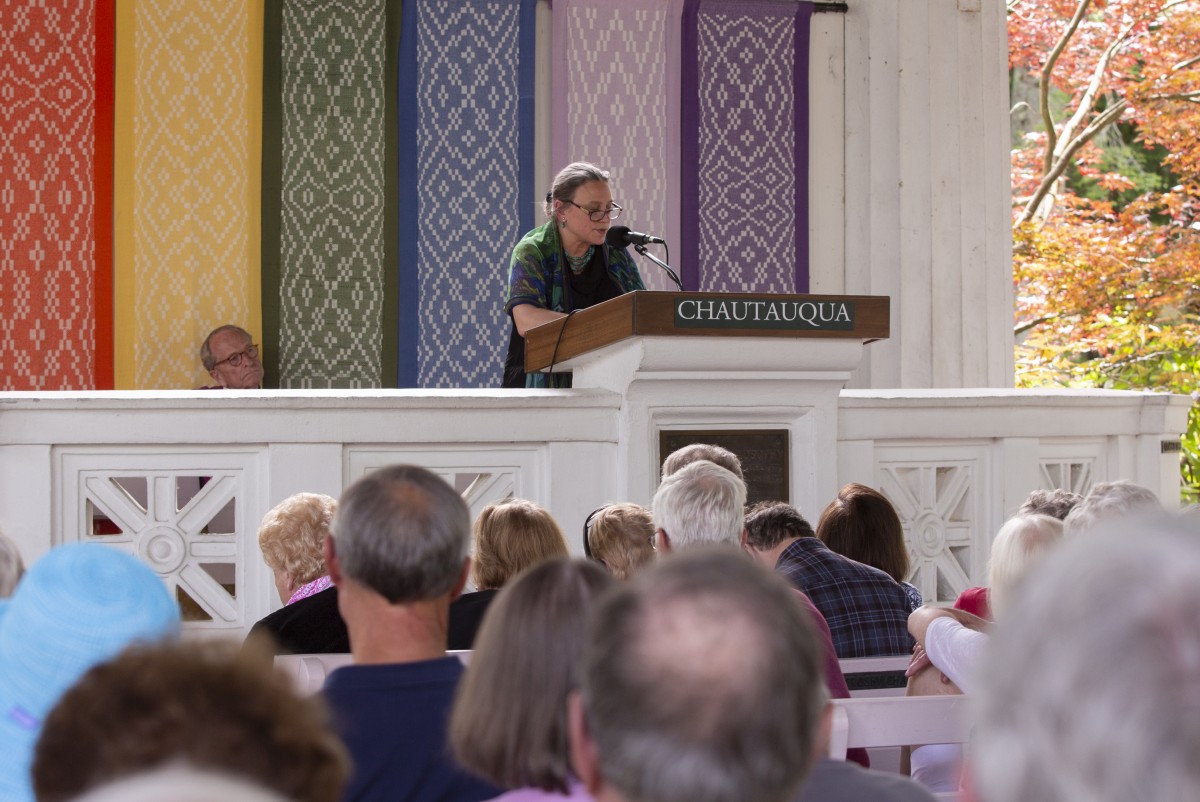To Laurie Patton, the Bhagavad Gita — also known as “the song of God” — represents an antidote to indecision and despair.
At 2 p.m. Monday, June 24 in the Hall of Philosophy, Patton, president of Middlebury College and Hindu scholar, kicked off Chautauqua’s Interfaith Lecture Series with “That Driver Must be God: How the Bhagavad Gita Changed the World.” The lecture was the first of Week One’s interfaith theme, “Religious Moments That Changed the World.”
The Bhagavad Gita is a 2,500-year-old sacred Hindu text, written originally in Sanskrit, that delves into the conversations between a prince named Arjuna, and Krishna, Arjuna’s driver and confidant.
Patton said readers will never fully know the identity of the Gita’s author, but that their decision to tell the story of Arjuna and Krishna would ultimately change the world.
“Somewhere near the Ganges, in a wooden hut … someone whose job it was to tell stories decided to tell a story about despair,” Patton said.
The primary source of conflict in the Gita, according to Patton, is the tension between Arjuna’s desire to fulfill his duties as a warrior and his commitment to protecting his relatives.
“Arjuna must grasp the heartbreaking fact that his enemies are his uncles and teachers and cousins,” Patton said. “He’s rendered speechless at this.”
The friction between two difficult choices represented in the Gita is a conflict shared by many other pieces of classic literature, according to Patton, such as Shakespeare’s Hamlet and the ancient Mesopotamian Epic of Gilgamesh.
“A decision in great literature can be a prism through which a culture is refracted into different modes of expression,” she said. “So, too, with the Bhagavad Gita. Its contents include simple and moving poetry, dense philosophy, moral musing and an explosive description of God.”
Patton, who authored a translation of the Gita for Penguin Classics, admits she is certainly not the first to interpret the sacred text in a different language.
“It has become a world classic, spawning over 250 translations, commentaries, renderings, paraphrases and synopses,” she said. “When I was asked to do the 251st translation of the Gita into English, I said, ‘There are no good reasons to do the 251st translation into English.’ ”
But Patton finds solace in her unique perspective as a woman translating the text, as well as the perspectives of the adult students she instructs in the lessons of the Gita.
She told a story about a student of hers, a Gulf War veteran, who experienced a moment of clarity upon realizing the similarities between the Gita and his own experiences in war. The student was completing a munitions transfer from Kuwait to Iraq, in a car with an unknown soldier as his driver. He said that the Gita would be “as if he stops the Humvee in the middle of our driving in this weird territory, and he idles the engine and he turns to me and says, ‘By the way, I’m God.’ ”
Beyond the fact that her students can make personal connections to the Gita, Patton believes in the Gita at its core.
“The central message — why the Gita is a text that changed the world — is it gives us the secret of how to act with discipline,” she said, “with hearts joined to God.”
“Krishna criticizes those who sacrifice with a view only to their own reward,” Patton said.
Yet Krishna also criticizes those who renounce the world entirely and desire a reward for that renunciation, according to Patton.
“It’s known in the West as ‘spiritual pride,’ ” she said. “The Gita teaches that clinging to your spiritual path is just as much a problem as not having one at all.”
The moral dilemma posed by the Gita initially reverberated throughout the Indian world, according to Patton.
“Up until the 18th century, we could say it was a text that changed the Indian world,” she said. “And then the British colonial environment and the rise of the East India Company provided a new stage for the emergence of the Gita, which changed the entire globe.”
The Gita was first translated into English by East India Company merchant Charles Wilkins, commissioned by Governor-General of India Warren Hastings in 1785.
Since then, Patton says the Gita has deeply influenced a variety of Western historical figures, from Henry David Thoreau, to J. Robert Oppenheimer to Martin Luther King Jr.
“There was someone else who took the key teaching of the Gita in a different direction,” she said. “He was a man who was fascinated by military strategy and how it could be turned into a moral force. His name was Gandhi.”
Patton said Mahatma Gandhi referred to the Gita as his “spiritual dictionary,” a text that would play a central role in his entire nonviolent philosophy.
“There are many political and strategic reasons that Gandhi pursued a nonviolent campaign,” she said. “But for him, the Gita was at the center of all of it.”
Indeed, Gandhi said: “Whenever doubts haunt me and disappointments stare me in the face, and I see not one ray of hope on the horizon, I turn to the Bhagavad Gita and find a verse to comfort me. I immediately begin to smile in the midst of overwhelming sorrow.”
And Patton said the Gita’s influence is detectable even now in the 21st century.
“Today, the Gita is a text in independent India,” she said. “It lives between East and West, between low caste and (high caste), rich and poor, secular and sacred.”
Patton said the Gita is a “meditation about action in war.”
“(The Gita) becomes a guidebook for a deeper, more transformative action of peace, of the nonviolent and of overcoming a paralysis against all odds,” Patton said.
Back in that wooden hut on the Ganges, Patton said, the story of despair and movement into action would eventually ring out across the ages.








